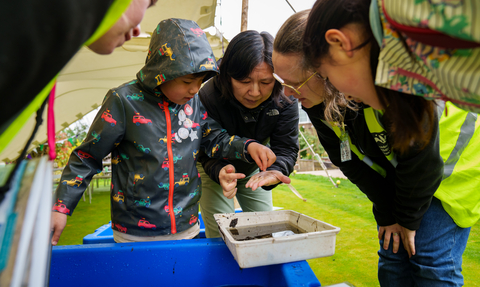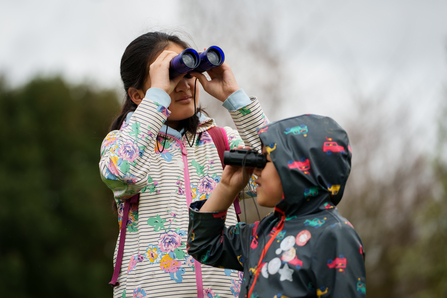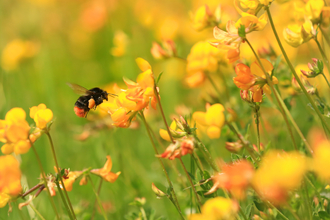
Local families learn about the power of water and its role in enabling nature to thrive
The All England Lawn Tennis Club, AELTC, ‘Wimbledon Park Project’
In late 2021, the Trust was invited to review proposals by the AELTC regarding the reconfiguration of Wimbledon Park, located adjacent to the AELTC Wimbledon facilities. AELTC along with local residents and London Wildlife Trust members asked us to provide our expertise and opinions, thoroughly examining the planning application documents and conducting multiple site visits, working closely with the ecology and landscape design team from Land Use Consultants (LUC).
The Trust's core ambition is to facilitate nature's recovery in London, advocating for land management practices that are sympathetic to wildlife. Encouraging all landowners to consider improving the ecological value of their land. In this regard, and after thorough examination of the planning application documents, we support the AELTC's plans for biodiversity and nature improvements. We particularly applaud the inclusion of daylighting two brooks and enhancing the lake habitat for wildlife, demonstrating how habitat improvements can be seamlessly integrated into a project while delivering net gains for nature.
We do however recognise that this is a contentious project. Despite its ambition to improve the ecology of Wimbledon Park and provide newly accessible greenspace, the project also has a series of contemporary interventions that will support and enhance the experience of the Wimbledon Championships- these elements are inherently antithetical to the original Capability Brown landscape and the current designation of this land as Metropolitan Open Land.

The London Wildlife Trust continues to actively contribute our expertise and knowledge to support the AELTC's Wimbledon Park Project, which will provide 23 acres of existing private land into a public park and achieve a minimum biodiversity net gain of 10% across the project site.
The collaboration of London Wildlife Trust and AELTC signifies our joint commitment to making nature accessible to all Londoners. This partnership not only emphasises the importance of enhancing the wildlife of London but also showcases the positive impact that can be achieved through collective efforts.
For more information on our position on the ecological assessment of this project, please read our FAQs below.
What is the Wimbledon Park Project?
The Wimbledon Park Project is intended to provide a new show court and additional tennis courts on land currently occupied by the private golf course. This is to allow the qualifying event for the Wimbledon Championships to be played at Wimbledon in order to maintain the Wimbledon Championships as the premier tennis tournament. In addition, the project aims to improve the park for the local community by providing public access to a large part of the park hitherto accessible only to golf club members and enhance the overall ecology of Wimbledon Park by restoring a range of habitats.
What area is affected by the project?
The entirety of Wimbledon Park comprises a municipal park (to the north and east), and large lake in the centre of the park (used for a range of water sports), the private Wimbledon Park Golf course (to the west and south) and the Wimbledon Club, which provides a range of sports facilities on land immediately to the west of the lake. The municipal park and lake are owned and managed by the London Borough of Merton and is fully accessible to the public. The Wimbledon Park golf course is owned by the AELTC and is not generally accessible to the public – it is this area that is included in the proposal.
What is the heritage status of the park?
Much of the park is a remnant of Lancelot ‘Capability’ Brown’s Landscaping of Earl Spencer’s Wimbledon Park in 1765. Although some of the original Capability Brown landscape is still extant, notably the lake and several of the trees retained or planted by Capability Brown, the creation of the golf course, the Wimbledon Club and the municipal park and associated sporting facilities has altered and masked the original landscape layout.
It is designated Metropolitan Open Land and the park is listed within the Register of Historic Parks and Gardens by English Heritage for its special historic interest as a Registered Park and Garden grade II*. It is also listed in the register of Heritage at Risk primarily because the ‘lake is in poor condition, designed views are obscured and the divided ownership results in discordant landscape management’.
A new show court set within Wimbledon Park would introduce a major new built feature into a relatively open landscape. Whether this is appropriate from a landscape perspective if for others to determine as landscape heritage per se is not an area that sits with the Trust’s remit unless the impact on landscape heritage would have a negative impact on the ecology of the site.
What is the ecological condition of the park?
With the exception of the public park, the site is designated as a Site of Borough Importance for Nature Conservation (SINC) Borough Grade 1. The SINC status is on account of ecological features such as the lake and marginal aquatic habitats, areas of rough grassland and a large number of veteran trees; the site also supports a large number of bats of various species, and a range of rare and uncommon invertebrates associated with the veteran trees and the lakeside habitats. The ecological value of the site is compromised by the intensive management of the golf course, the siltation of the lake and the poor quality of water entering the lake, and areas of excessive lighting that disrupt foraging behaviour of the more sensitive bat species such as Daubenton’s bat.
The existing golf course is very intensively managed by mowing (even in areas of rough), so its current ecological value is largely limited to the avenues of trees dividing the fairways, and a few locations where a relaxed management regime has allowed some pockets of rough grassland and wildflowers to become established. Even though most of the veteran trees are located in less intensively managed areas, their nature conservation value is constrained by the fact that they are not situated within complementary habitats and, in some cases, have been ‘boxed in’ by trees (often of incompatible species) planted at a much later date which have constrained the spreading aspect of the former parkland trees.
Many of the invertebrate species associated with veteran trees also require areas of semi-natural grassland to complete their lifecycles. Likewise, species such as bats, which may use the veteran trees for roosting and foraging, will also fare better if the veteran trees were associated with other semi-natural grassland that provide additional foraging habitat. Use of pesticides on the golf course greens and fairways will also be limiting species diversity and contributing to some of the aquatic pollution of the lake. The two main watercourses feeding the lake are largely culverted beneath the golf course fairways.
How does the project propose to improve the ecological condition of the park?
With the information currently available to LWT we do not consider that a new show court within Wimbledon Park would have a significant impact on the ecology of the site, provided the structure was sensitively designed and operated and the other proposals for ecological enhancement across the park were fully implemented, including the potential additional mitigation/enhancement measures described below.
The lake and the veteran trees are currently the most important ecological features of Wimbledon Park. However, the lake’s value is compromised by many years of siltation, inflow of sometimes polluted water, and limited areas of marginal aquatic habitat and clearly demarcated and managed wildlife sanctuary areas. The Wimbledon Park Project offers a potential solution to resolving some of these limitations on the ecology of the lake by providing direct benefits, such as the opening of culverts and installation of pollution control measures, and indirect benefits such the catalyst for and funding of the desilting and enhancement of the lake and lakeside habitats, such as reedbeds.
Although, in part, replacing the intensively managed golf course with a large number of highly maintained grass courts will result in like-for-like replacement of rather sterile habitats, the proposed layout of the courts and the proposed management of the spaces between the courts would result in a greater extent of semi-natural habitat that could be created and managed to be more in keeping with the original acid grassland and meadows envisaged by Capability Brown.
We are particularly interested in the opportunity to test and trail acid grassland restoration techniques involving exposing underlying soils and potentially augmenting any regeneration from the seedbank with seeds and plant material from nearby semi-natural habitats at Wimbledon Common and other local remnants of acid grassland or heathland habitat. It would also seem that the new courts would occupy only about half of the current area taken by the golf course, thus allowing for other opportunities for habitat creation on the area proposed to be dedicated as an accessible public park.
How will the project improve access to the park?
Currently public access is limited to the municipal park to the north of the site and the lake which occupies the centre of Wimbledon Park. Although the lake has nature conservation interest which contributes to the SINC status of Wimbledon Park, much of the municipal park is of limited nature conservation interest except for the woodland along its northern boundary.
The proposal to landscape and ecologically enhance the land currently occupied by the golf course to the south of the lake and make this an accessible public park for most of the year, significantly increase the local community’s ability to enjoy and appreciate the natural world close to where they live; especially for those residents living to the east of Wimbledon Park who are not within a reasonable walking distance of Wimbledon Common. The proposed provision of new entrances and walking loops that include the new park and board-walked routes through new habitats created around the lake will offer visitors a variety of experiences of nature.
London Wildlife Trust representations to the London Boroughs of Wandsworth and Merton
Please see the following letters for more information:
London Wildlife Trust's positioning
London Wildlife Trust, works closely with various stakeholders including government agencies, community groups, nature conservation charities, local authorities, housing associations, corporates, and developers. We aim to create a London alive with nature, where everyone can experience and enjoy wildlife.
We recognise that this is a contentious project. Despite its ambition to improve the ecology of Wimbledon Park and restore some of the original design elements of the Capability Brown landscape the project is also a series of contemporary interventions that will support and enhance the experience of the Wimbledon Championships, these elements are inherently antithetical to the original Capability Brown landscape and the current designation of this land as Metropolitan Open Land.
We acknowledge that our ambitions to see all suitable land in London managed as sympathetically as possible for wildlife have to be achieved in the context of a dynamic, ever-changing city with multiple legitimate and sometimes conflicting uses for land. We do not compromise where wildlife conservation should be the primary consideration for the use and management of land such as sites comprising high quality priority habitat such as ancient woodland or chalk grassland; however, we want to collaborate with landowners who are actively seeking to improve the ecological value of their land by integrating it with their primary purpose for owning and managing land.

